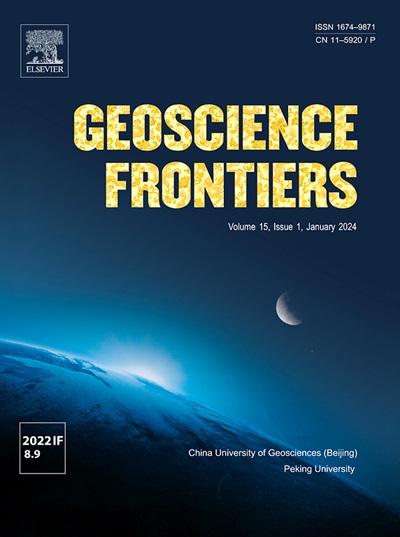逆冲闪长岩叠加的两期花岗岩变质作用中国中部秦岭造山带早古生代构造演化的约束条件
IF 8.5
1区 地球科学
Q1 GEOSCIENCES, MULTIDISCIPLINARY
引用次数: 0
摘要
现有研究为中国中部北秦岭造山带约500 Ma超高压变质作用提供了充分的岩石学证据,但北秦岭造山带470-420 Ma多相花岗岩质变质作用的成因及其与约500 Ma超高压变质作用的关系仍存在争议,导致古生代早期秦岭造山带的演化备受争议。500Ma超高压变质作用的关系仍存在争议,导致秦岭造山带早古生代演化备受争议。本研究揭示了北秦岭造山带东部双龙地区具有 "红眼凹陷 "纹理的黑云母花岗岩和寄主长英片麻岩,它们记录了花岗岩派变质作用与前独斜岩派变质作用叠加的两个阶段。锆英石痕量元素模式和496-495Ma锆英石年龄与北大堡地区HP-UHP黝帘石变质岩的锆英石痕量元素模式和496-495Ma锆英石年龄一致,表明了前黝帘石变质作用。第一次花岗岩-派变质作用发生在460-448 Ma,基质矿物为粗粒矿物。这些矿物的组成和分带确定了一条逆时针的 P-T 路径,包括一个顺行阶段(751-763 °C)、一个高温峰值阶段(9.2 千巴和 864 °C)以及一个接近等压冷却的逆行阶段(8.3 千巴和 818 °C)。第二次花岗岩成因变质发生在422-421 Ma,以日冕石榴石和共生细粒矿物集合体为代表。日冕石榴石成分分带显示了一条顺时针的P-T路径,包括高压峰值阶段(9.5-11.2千巴和748-783 °C)和减压加热逆行阶段(9.2-9.5千巴和789-800 °C)。结合这些岩石中白云母的测年结果和已有数据,我们提出了一个新的北秦岭早古生代构造演化模型。北秦岭地层可能在罗迪尼亚解体过程中从华南地块分离出来,向北漂移,在500Ma时经历了超高压变质作用,然后迅速出露到地壳水平。之后,商丹洋在470-440Ma时向北俯冲到被掘出的NQT之下,导致了第一次花岗岩质变质作用以及同期的岩浆移行作用。最后,商丹洋的关闭导致了北秦岭地层与南秦岭地层/SCB的碰撞,并在422-418Ma发生了第二次花岗岩-成因变质作用和岩浆作用。本文章由计算机程序翻译,如有差异,请以英文原文为准。

Two phases of granulite-facies metamorphism superimposied on retrograde eclogite: Constraints on the early Paleozoic tectonic evolution of the Qinling Orogenic Belt, central China
Existing studies provide adequate petrological evidences on ca. 500 Ma ultra-high pressure (UHP) metamorphism in the North Qinling Orogenic Belt (NQOB) in central China, but the genesis of 470–420 Ma multi-phase granulite-facies metamorphism in the NQOB and their relationship with the ca. 500 Ma UHP metamorphism remain controversial, resulting in the early Paleozoic evolution of the Qinling Orogenic Belt (QOB) highly debatable. In this study, we present mafic granulites and host felsic gneisses with a “red-eye socket” texture from the Shuanglong area, eastern NQOB, which recorded two phases of granulite-facies metamorphism superimposing on former eclogite-facies metamorphism. The former eclogite-facies metamorphism is indicated by eclogite-facies zircon trace element patterns and 496–495 Ma zircon ages, which are the same with those of the HP–UHP eclogite-facies metamorphic rocks in NQOB. The first granulite-facies metamorphism occurred at 460–448 Ma is characterized by coarse-grained minerals in matrix. Compositions and zonings of these minerals define an anticlockwise P–T path involving a prograde stage (751–763 °C), a high-temperature peak stage (9.2 kbar and 864 °C), and a near-isobaric cooling retrograde stage (8.3 kbar and 818 °C). The second granulite-facies metamorphism occurred at 422–421 Ma is represented by coronal garnet and coexisting fine-grained mineral aggregates. Coronal garnet compositional zonings suggest a clockwise P–T path consisting of a high-pressure peak stage (9.5–11.2 kbar and 748–783 °C) and a decompressing and heating retrograde stage (9.2–9.5 kbar and 789–800 °C). Combining dating results of leucosomes in these rocks and existing data, we proposed a new model for early Paleozoic tectonic evolution of the NQOB. The North Qinling Terrane (NQT), probably separated from the South China Block (SCB) during the breakup of Rodinia, drifted northwards and underwent UHP metamorphism at 500 Ma and then rapidly exhumed to crust level. Later, the Shangdan Ocean subducted northwards beneath the exhumed NQT at 470–440 Ma, resulting in the first granulite-facies metamorphism and contemporaneous migmatization and magmatism. Finally, the closure of the Shangdan Ocean led to collision between the NQT and South Qinling Terrane/SCB and the second granulite-facies metamorphism and anatexis at 422–418 Ma.
求助全文
通过发布文献求助,成功后即可免费获取论文全文。
去求助
来源期刊

Geoscience frontiers
Earth and Planetary Sciences-General Earth and Planetary Sciences
CiteScore
17.80
自引率
3.40%
发文量
147
审稿时长
35 days
期刊介绍:
Geoscience Frontiers (GSF) is the Journal of China University of Geosciences (Beijing) and Peking University. It publishes peer-reviewed research articles and reviews in interdisciplinary fields of Earth and Planetary Sciences. GSF covers various research areas including petrology and geochemistry, lithospheric architecture and mantle dynamics, global tectonics, economic geology and fuel exploration, geophysics, stratigraphy and paleontology, environmental and engineering geology, astrogeology, and the nexus of resources-energy-emissions-climate under Sustainable Development Goals. The journal aims to bridge innovative, provocative, and challenging concepts and models in these fields, providing insights on correlations and evolution.
 求助内容:
求助内容: 应助结果提醒方式:
应助结果提醒方式:


